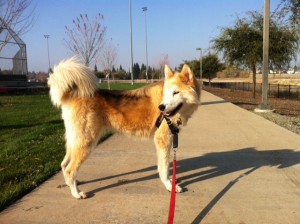Shasta’s Battle With SARDS
Posted on December 3rd, 2013This is a guest post by Michelle Cunningham.
After receiving the crushing news that our beloved Alaskan Malamute/German Shepherd, Shasta, was rapidly going blind, due to her SARDS diagnosis on Aug 8th 2013, I was told there's no known cause and no known cure for this illness. I was assured Shasta would adapt to her environment, and she can still live a happy and full life. My vet referred me to an ophthalmologist who ran some tests and the results were that she had no menace, the ERG showed a flatline, but the overall health of her eyes were good. The doctor said there was retinal thinning showing that she said she normally wouldn't see until approx 6 months after SARDS onset.
I consulted with Dr. Plechner after reading a blog I found on the internet about a dog named Reo. Dr. Plechner suggested I get the EI-1 blood panel done on Shasta to take a look at her hormone levels, so I did. Once we received the results I had already received Dr. P’s protocol during our consultation and neither my vet, the ophthalmologist, nor the internist wanted anything to do with this protocol and didn’t feel that her test results showed anything that would necessitate treatment of any kind. I could see I wasn’t going to get treatment in a timely fashion from anyone in the Sacramento area so I hopped in the car with Shasta and we drove down to LA to see Dr. P. in person. He was able to give Shasta an exam, treat her in the clinic, and prescribe the medication she needed. Over the next several weeks Dr. P. taught me about nutrition for dogs with this condition, taught me about malabsorbtion and how it affects her overall health, the plausible causes of the onset of this condition, and most of all he provided me with confidence that with the proper protocol in place and proper diet regimen, Shasta would live a long and healthy life and possibly save some of her vision.
As soon as Shasta started the protocol and I changed her diet I saw a big improvement in her demeanor. She wasn’t panting as much, she wasn’t drinking as much water, and I could start to see her personality come back. After about a month I noticed that Shasta had some really good days with her vision. She would reach for the step when we would walk across the street and her eyes would follow people or dogs walking in the distance even if she did not hear them. Shasta would have good and bad days for a while and the bad days would come after a day of a lot of excitement or stress. If we had people over the house for a period of time, or we took her somewhere she wasn’t familiar with, I could tell her vision would decrease because she would start banging into things, her eyes would get very dilated and then her demeanor would change and she would seem depressed, sometimes not even wanting to go on walks. It would then take a day or two before she would bounce back and have another good couple of days. Another thing that would contribute to her having a bad day as far as her vision is if she got a hold of something that didn’t agree with her. If she would have mucus in her stool or had runny stool, her vision would not be good. I have spent a lot of time researching commercial dog foods and their ingredients and I finally came to the conclusion that for Shasta, the raw food diet was working best. Not to say that won’t change in the future.
Dr. Plechner also taught me about other contributing environmental factors such as vaccines, insect repellants and household cleaners. I immediately threw everything out and replaced products with natural earth friendly products. I noticed that Shasta’s eyes would get a little foggy looking from time to time and thought I should get her eyes checked out to make sure there was not an infection of some kind. Our visit to the ophthalmologist turned out better than expected… The doctor actually said that it seemed like Shasta has some slight vision, which I was surprised because her initial exam showed she had no vision at all other than light transition and maybe shadows. Although I can tell that Shasta's left eye is worse than her right eye the test results compared to her initial visit a month ago, Shasta's right eye showed slight menace and slight dazzle and still has pupil dilation in both eyes.
I had the EI-1 blood panel repeated twice since starting Dr. P.’s protocol just to see if the doses needed to be adjusted. Each test showed improvement in all areas. Her total estrogen level is coming down as expected, her IgA is increasing so her immune system is getting stronger, and her T3 and T4 levels are perfect. I have to say that since Shasta has started Dr. Plechner's treatment for her high estrogen and changing her diet, in addition to her improved vision, demeanor and increased energy, she has not been itching at all and she is no longer shedding like she used to. : ) Her coat is beautiful again and she is almost up to her ideal weight. I’ve had people come over the house (and everyone knows about Shasta’s condition) and say, “can she see now??” because she seems to look right at people and they watch her navigate around the house and backyard.
 My dog is my child and I don’t want to even think about losing her…it was never an option for me to lose her. I was determined to find out more about why this was happening to her and what could be done. Thank God, I found someone out there that had this same notion many years ago, did extensive research, and overcame hurdles from the mainstream vet world to stomp out his theories. I’m so proud of Dr. Plechner and all that he has achieved in his lifetime and I’m inspired by his strong will and dedication to help animals.
My dog is my child and I don’t want to even think about losing her…it was never an option for me to lose her. I was determined to find out more about why this was happening to her and what could be done. Thank God, I found someone out there that had this same notion many years ago, did extensive research, and overcame hurdles from the mainstream vet world to stomp out his theories. I’m so proud of Dr. Plechner and all that he has achieved in his lifetime and I’m inspired by his strong will and dedication to help animals.
On a physiological note…I am not a doctor or a scientist, but the Plechner Syndrome is real and his protocol gets results. I do not believe that his patients follow his protocol merely on blind faith, I truly believe his research makes sense and if people would listen, the theory is logical. Many researchers are finally finding this to be true as well and the more people can talk about it and reach broad audiences the more quickly other pets can be saved or even prevented from becoming ill or dying.


Awesome!